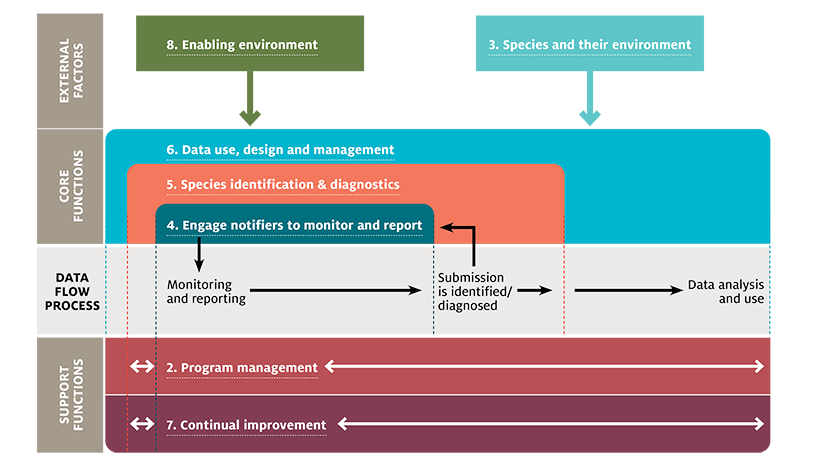Authors: Heleen Kruger, Jen Ticehurst and Alex van der Meer Simo
Summary
Engaging people from all walks of life in the monitoring and reporting of pests, weeds and diseases is called general surveillance. Instigating and maintaining general surveillance programs are no easy feat. The General surveillance program guidelines (the Guidelines) have been developed to help program coordinators, policy-makers, funders and those who monitor and evaluate general surveillance programs to understand the key considerations for designing, planning and implementing such programs. It is relevant to all biosecurity sectors, including plant, animal, marine, weed and the environment.
The Guidelines are based on systems thinking and the lessons learned from 9 case studies from across plant, animal, marine, weeds and the environment sectors in Australia and New Zealand. The Guidelines have been refined with feedback from 140 experts who work on different parts of general surveillance programs.
Following the use of systems thinking, the Guidelines provide a bird’s eye view of the main parts of general surveillance programs and some of the key interactions between them, rather than in-depth guidance on any particular part. The Guidelines are structured around the key functions and elements of general surveillance programs:
- program management - including resourcing and getting started;
- the species involved and their environment;
- engaging notifiers to monitor and report;
- species identification and disease diagnostics;
- data use, design and management;
- continual improvement;
- an enabling environment.
Checklists are provided below as a summary of the Guidelines for three target groups: program staff, policy-makers and senior staff, and funders.
More detailed findings about the case studies are contained in the Research Report titled Making general surveillance programs work – Lessons from nine case studies. The Research Report contains the main evidence base for the Guidelines, but the structure of the two documents differs considerably. To help readers of the Guidelines find background information in the more detailed Research Report, a cross referencing tool is provided below:
High resolution version of Figure 2
Download the Guidelines
Download the checklists
| Document | File size |
|---|---|
| Checklist for program staff PDF | 455 KB |
| Checklist for program funders PDF | 330 KB |
| Checklist for policy-makers and senior managers PDF | 327 KB |
Download the cross-referencing tool with the Research report
Cross Referencing Tool (PDF 193 KB)
If you have difficulty accessing these files, visit web accessibility for assistance.
An overview of the Guidelines chapters
This chapter defines general surveillance programs and provides background to the Guidelines, including the research approach and an overview of the case studies.
This chapter outlines considerations related to general surveillance program management, such as setting the scope, resourcing, getting a program started, context alignment, knowledge integration, identifying roles and responsibilities, and establishing connectivity and networks.
This chapter provides key considerations for program design and implementation related to pests, weeds and diseases and their environment, such as detectability, source and spread pathways, temporal and environmental factors and people’s attitudes to certain species and diseases.
Download Chapter 3 – Pests, weeds and diseases and their environment (PDF 545 KB)
In this chapter an overview of key target groups is presented along with ways to attract and maintain their support. It provides considerations for reporting avenues including designing reporting tools. It also covers duty of care including: health and safety; liability, privacy and confidentiality and intellectual property.
Download Chapter 4 – Engaging notifiers to monitor and report (PDF 948 KB)
This chapter outlines what needs to be considered for pest and weed identification and disease diagnosis, including how it is undertaken, preventing labs and herbariums from being overwhelmed, maintaining specimen and sample quality and other considerations for data accuracy and timeliness.
Download Chapter 5 – Pest and weed identification and disease diagnosis (PDF 538 KB)
In this chapter various aspects of data are discussed, including understanding end-users’ data requirements, sampling approach, as well as data capture, flow, storage and value.
Download Chapter 6 – Data use, design and management (PDF 570 KB)
This chapter offers considerations for embedding monitoring and evaluating general surveillance programs, managing risks and looking out for systems interactions.
This chapter contains key factors in the broader context that can influence the success of general surveillance programs, including broader rules and regulations, relationships and networks, capability and capacity, and resourcing.

